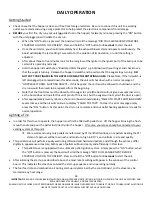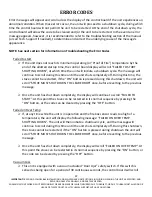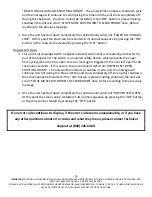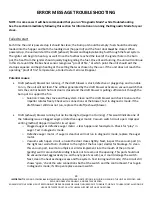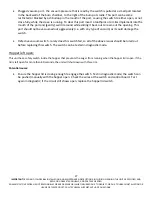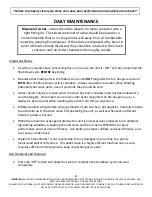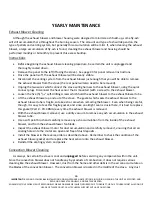
25
IMPORTANT!
READ
AND
FOLLOW
ALL
INSTALLATION
AND
MAINTENANCE
INSTRUCTIONS,
INCLUDING
CLEANING
THE
UNIT
AS
SPECIFIED,
AND
REPLACING
GASKETS
ANNUALLY,
AND
PARTS
AS
NEEDED.
ENGLAND’S
STOVE
WORKS
IS
NOT
RESPONSIBLE
FOR
ANY
DAMAGE
OR
INJURY
INCURRED
DUE
TO
NEGLECT,
OR
DUE
TO
UNSAFE
INSTALLATION
OR
USAGE
OF
THIS
PRODUCT.
CALL
TECHNICAL
SUPPORT
WITH
ANY
QUESTIONS.
o
Improper
venting
method
‐
as
stated
above,
one
of
the
key
requirements
for
proper
operation
is
proper
airflow
through
the
entire
system.
Venting
systems
with
excessive
elbows
and/or
long
horizontal
runs
can
restrict
the
flow
of
air
to
the
point
that
the
vacuum
switch
may
not
receive
enough
pressure
to
hold
it
closed.
This
would
prevent
feed,
as
the
control
board
would
assume
the
front
door
is
open.
A
dirty
flue
system
can
restrict
airflow
in
the
same
manner,
even
if
installed
correctly.
Refer
to
the
installation
guide
to
determine
if
the
installation
is
within
specifications.
o
Hopper
lid
switch
circuit
open
‐
ensure
the
hopper
lid
is
closing
enough
to
engage
the
switch.
Test
in
diagnostic
mode.
Ensure
the
switch
can
be
pushed
manually
with
hopper
open.
Check
wires
at
switch
and
control
board;
test
again
in
diagnostic
mode.
If
the
circuit
still
shows
‘open,’
replace
the
hopper
lid
switch.
Feeds
but
doesn’t
light
‐
Test
igniter
in
diagnostic
mode;
remove
the
burn
pot
for
observation.
After
energizing
the
ignitor
circuit,
allow
approximately
4
minutes
for
the
cartridge
to
fully
heat
up
and
observe
the
igniter
sleeve.
Check
wires
at
igniter.
Replace
igniter.
Stove
lights
but
still
has
error
‐
Test
firebox
sensor
in
diagnostic
mode.
Check
connection
at
control
board.
Verify
mounting
screw
for
sensor
on
exhaust
coupler
is
tight.
Replace
firebox
heat
sensor.
Over
Temp
An
over
temp
error
message
will
appear
when
the
firebox
heat
sensor
reads
too
high
of
a
temperature.
The
unit
can
produce
a
large
amount
of
heat,
which
is
convected
out
into
the
room
by
a
convection
(room
air)
blower
that
runs
at
a
rate
determined
by
the
control
board.
If
the
stove
is
unable
to
shed
the
generated
heat,
the
unit
itself
will
retain
a
higher
percentage
of
this
heat
and
eventually
will
shut
down.
Potential
causes:
Room
air
blower
not
running
or
dirty
‐
test
in
diagnostic
mode.
If
the
blower
does
not
run,
remove
side
panels
and
verify
the
“squirrel
cage”
fans
rotate
freely.
Clean
out
the
fans.
Check
wire
connections.
Replace
room
air
blower.
Excessive
ash
buildup
or
improper
venting
‐
remove
cleanout
covers
and
clean
the
heat
exchange.
Improper
venting
method
/
Clean
flue
system
‐
as
stated
above,
one
of
the
key
requirements
for
proper
operation
is
proper
airflow
through
the
system.
Venting
systems
with
excessive
elbows
and/or
long
horizontal
runs
can
restrict
the
flow
of
air,
causing
a
buildup
of
fuel
in
the
burn
pot
and
higher
exhaust
temperatures.
Also,
a
dirty
vent
system
does
not
allow
as
much
heat
transfer,
causing
excessive
heat
to
be
wasted
through
the
exhaust,
where
the
firebox
heat
sensor
is
located.
Confined
space
‐
If
the
unit
is
installed
in
a
small
room
or
alcove
which
does
not
allow
proper
circulation
of
heat,
the
unit
itself
could
simply
get
too
hot.
Refer
to
the
installation
guide
to
determine
if
the
installation
is
within
specifications.








